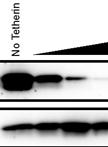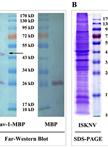- Submit a Protocol
- Receive Our Alerts
- Log in
- /
- Sign up
- My Bio Page
- Edit My Profile
- Change Password
- Log Out
- EN
- EN - English
- CN - 中文
- Protocols
- Articles and Issues
- For Authors
- About
- Become a Reviewer
- EN - English
- CN - 中文
- Home
- Protocols
- Articles and Issues
- For Authors
- About
- Become a Reviewer
Coupling of HIV-1 gp120-derived Core Protein to Paramagnetic Beads and Adsorption Assays
Published: Vol 5, Iss 20, Oct 5, 2015 DOI: 10.21769/BioProtoc.1614 Views: 7321
Reviewed by: Savita NairAnonymous reviewer(s)

Protocol Collections
Comprehensive collections of detailed, peer-reviewed protocols focusing on specific topics
Related protocols

HIV-1 Virus-like Particle Budding Assay
Nathan H Vande Burgt [...] Paul Bates
Jul 20, 2013 11098 Views

Construction of a Highly Diverse mRNA Library for in vitro Selection of Monobodies
Taishi Kondo [...] Hiroshi Murakami
Aug 20, 2021 3795 Views
Abstract
Analysis of the functional activity in polyclonal serum following immunization of a complex protein or glycoprotein immunogen is a very important but tedious process. Fine mapping of epitope-specific antibodies is difficult when they are elicited at relatively low levels. In our recent study focused on developing an HIV-1 vaccine, we immunized rabbits with hyperglycosylated stable core immunogens, which were designed using high-resolution structural information to elicit antibodies against the primary receptor-binding, CD4-binding site on HIV-1 gp120. Using a solid phase adsorption assay, we could map the serum antibodies to the conserved CD4-binding site, a known broadly neutralizing determinant on exterior envelope glycoprotein, gp120.
Materials and Reagents
- 15 ml polystyrene tube (BD, Falcon, catalog number: 352096 )
- Dynabeads® MyOneTM Tosylactivated (Thermo Fisher Scientific,Dynal Biotech, catalog number: 65501 )
- Magnetic separator (Thermo Fisher Scientific,Dynal MPC, catalog number: 12301D )
- Bovine serum albumin (BSA) (Biopioneer, catalog number: C0100 )
- Recombinant protein (core gp120) to couple to the beads [expressed and purified in-house. Please check Ingale et al. (2014)]
- Sodium azide (Sigma-Aldrich, catalog number: 438456 )
- DMEM (Thermo Fisher Scientific, GibcoTM, catalog number: 10313-021 )
- Fetal Bovine Serum (VWR International, Seradigm, catalog number: 1300-500 )
- Protease inhibitor (Roche Diagnostics, catalog number: 11255500 )
- Glycine-HCl (Sigma-Aldrich, catalog number: G2879 )
- Sodium borate (AMRESCO, catalog number: 0390 )
- Ammonium sulfate, 99+%, ACS reagent (Thermo Fisher Scientific, ACROS ORGANICS, catalog number: 42340-0010 )
- Coupling buffer (see Recipes)
- Blocking buffer (see Recipes)
- Wash buffer (see Recipes)
- Coating buffer (see Recipes)
Equipment
- Magnetic separator (Thermo Fisher Scientific,Dynal MPC, catalog number: 12301D )
- Absorbance reader (Molecular Devices, model: Spectramax Plus )
Procedure
Dynabeads MyOne Tosylactivated beads are superparamagnetic, polystyrene beads with polyurethane layer designed for bio-magnetic separations. These beads were freshly tosyl-activated, coupled with selected core gp120 variants. We used the core-conjugated Dynal beads to fractionate site-specific antibodies from polyclonal anti-sera elicited by HIV-1 core immunization. Anti-sera were adsorbed over isogenic glycoprotein antigens possessing epitope-specific mutations that were covalently attached to the Dynabeads. Following this adsorption method we were able to enrich and detect antibodies elicited against the desired epitope.
- Conjugation of protein/glycoprotein to the Dynabeads
- Tosyl-activated paramagnetic Dynabeads were washed by transferring beads to a tube placed on a magnet until the beads migrated to the side of the tube and the liquid was clear. The tube was removed from the magnet and beads were resuspended in 1 ml of coating buffer. The tube was again placed on the magnet and the liquid removed. These beads were then used as described below.
- 2 mg protein (at a concentration of >5 mg/ml) was mixed with 100 mg (1 ml, initial volume before washing the beads) tosyl-activated paramagnetic Dynabeads in a total volume of 2.5 ml of coupling buffer with slow tilt rotation at 37 °C for 16-to-24 h in a 15 ml polystyrene tube.
- The tube was inserted into the magnetic separator for 2 min to separate the glycoprotein-conjugated beads from buffer containing unconjugated, free protein. Non-covalently linked protein was discarded.
- The Dynabeads were resuspended in 1.25 ml blocking buffer at 37 °C for additional 16-to-24 h.
- The Dynabeads were washed 3 times with 2 ml wash buffer at room temperature and stored at 4 °C in 500 μl PBS containing 0.02% sodium azide and protease inhibitor (1 tablet in 50 ml). Beads were separated between each wash on the magnetic separator.
- Tosyl-activated paramagnetic Dynabeads were washed by transferring beads to a tube placed on a magnet until the beads migrated to the side of the tube and the liquid was clear. The tube was removed from the magnet and beads were resuspended in 1 ml of coating buffer. The tube was again placed on the magnet and the liquid removed. These beads were then used as described below.
- Solid phase adsorption
- Protein-coupled Dynabeads were washed three times with 2 ml DMEM containing 10% FBS and incubated for 30 min at RT to block nonspecific binding sites on the beads. Between every wash beads were separated using the magnetic separator.
- Rabbit sera derived from the same group of animals were pooled and diluted 40-fold with DMEM. Eighty μl of the diluted sera was added to 100 μl of protein-conjugated beads and incubated for additional 30 min with gentle rocking at room temperature. Rabbit sera were obtained from a separate immunization experiment, where rabbits were immunized with HIV-1 core glycoptoteins.
- Un-bound serum antibodies were separated from the protein-conjugated beads using a magnet.
- Multiple rounds of adsorption were performed. Fresh protein-coupled Dynabeads were used for each round of adsorption for complete removal of specific antibodies from the diluted serum to the solid phase.
- For each set of serum adsorptions, blank beads, (same amounts as the experimental beads) devoid of protein were used as negative controls.
- To check for the complete enrichment of core- and site-specific antibodies, serum IgGs were eluted from the beads by addition of 100 mM Glycine-HCl (pH 2.7). In parallel, the serum fractions containing un-bound antibodies were also analyzed. ELISAs were performed using wild-type and site-specific mutant proteins as targets on the ELISA plate as described in Ingale et al. (2014).
- Protein-coupled Dynabeads were washed three times with 2 ml DMEM containing 10% FBS and incubated for 30 min at RT to block nonspecific binding sites on the beads. Between every wash beads were separated using the magnetic separator.
Recipes
- Coupling buffer
0.1 M sodium borate (pH 9.5) with 1 M ammonium sulfate - Blocking buffer
PBS (pH 7.4) with 0.5% (wt/vol) BSA and 0.05% Tween-20 - Wash buffer
PBS (pH 7.4) with 0.1% (wt/vol) BSA and 0.05% Tween-20 - Coating buffer
0.1 M sodium borate (pH 9.5)
Acknowledgments
This protocol was previously used in Ingale et al. (2014).
References
- Ingale, J., Tran, K., Kong, L., Dey, B., McKee, K., Schief, W., Kwong, P. D., Mascola, J. R. and Wyatt, R. T. (2014). Hyperglycosylated stable core immunogens designed to present the CD4 binding site are preferentially recognized by broadly neutralizing antibodies. J Virol 88(24): 14002-14016.
Article Information
Copyright
© 2015 The Authors; exclusive licensee Bio-protocol LLC.
How to cite
Ingale, J. and Wyatt, R. T. (2015). Coupling of HIV-1 gp120-derived Core Protein to Paramagnetic Beads and Adsorption Assays. Bio-protocol 5(20): e1614. DOI: 10.21769/BioProtoc.1614.
Category
Immunology > Antibody analysis > Antibody detection
Microbiology > Microbial biochemistry > Protein > Immunodetection
Do you have any questions about this protocol?
Post your question to gather feedback from the community. We will also invite the authors of this article to respond.
Share
Bluesky
X
Copy link









